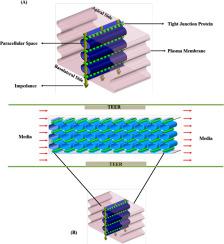当前位置:
X-MOL 学术
›
Microelectron. Eng.
›
论文详情
Our official English website, www.x-mol.net, welcomes your
feedback! (Note: you will need to create a separate account there.)
Impact of serum concentration in cell culture media on tight junction proteins within a multiorgan microphysiological system
Microelectronic Engineering ( IF 2.6 ) Pub Date : 2020-08-01 , DOI: 10.1016/j.mee.2020.111405 Abdul Rahim Chethikkattuveli Salih , Hafiz Muhammad Umer Farooqi , Young Su Kim , Sang Ho Lee , Kyung Hyun Choi
Microelectronic Engineering ( IF 2.6 ) Pub Date : 2020-08-01 , DOI: 10.1016/j.mee.2020.111405 Abdul Rahim Chethikkattuveli Salih , Hafiz Muhammad Umer Farooqi , Young Su Kim , Sang Ho Lee , Kyung Hyun Choi

|
Abstract A key problem hindering the regulation and approval of organ-on-chip technology by international drug regulatory agencies is the lack of standardization. This study aims to evaluate the impact of different concentrations of fetal bovine serum (FBS) on tight junction formation between cells in a microphysiological system (MPS). Hence, a standardized FBS concentration in cell culture media used for MPSs can be proposed. Caco-2, HepG2, and HK-2 immortal cell lines representing gut, liver and, kidney organ models, respectively were cultured in microphysiological devices and monitored in real-time for transepithelial electrical resistance (TEER) and pH over a six-days period. Glass-based microfluidic chips with embedded TEER electrodes were utilized to measure the impedance of the cell monolayers. Considering albumin, kidney injury molecule-1 (KIM-1), and alkaline phosphatase biomarkers, the results obtained using cell culture media containing 5% FBS were more physiologically relevant, when compared to media containing 0% and 10% FBS. E-cadherin confocal microscopy and a live dead cell assay were performed and compared with TEER data to confirm this claim. This optimized FBS concentration should enable microphysiological platforms to perform at an optimum cell culture capacity, facilitating robust pathophysiology, drug toxicity as well as, absorption, distribution, metabolism, and excretion (ADME) studies.
中文翻译:

细胞培养基中血清浓度对多器官微生理系统内紧密连接蛋白的影响
摘要 缺乏标准化是阻碍国际药品监管机构对片上器官技术进行监管和审批的一个关键问题。本研究旨在评估不同浓度的胎牛血清 (FBS) 对微生理系统 (MPS) 中细胞间紧密连接形成的影响。因此,可以提出用于 MPS 的细胞培养基中的标准化 FBS 浓度。分别代表肠道、肝脏和肾脏器官模型的 Caco-2、HepG2 和 HK-2 永生细胞系在微生理装置中培养,并在六天内实时监测跨上皮电阻 (TEER) 和 pH 值. 带有嵌入式 TEER 电极的玻璃基微流体芯片用于测量细胞单层的阻抗。考虑到白蛋白,肾损伤分子 1 (KIM-1) 和碱性磷酸酶生物标志物,与含有 0% 和 10% FBS 的培养基相比,使用含有 5% FBS 的细胞培养基获得的结果在生理上更具相关性。进行了 E-钙粘蛋白共聚焦显微镜检查和活死细胞测定,并与 TEER 数据进行了比较以证实这一说法。这种优化的 FBS 浓度应该使微生理平台能够以最佳的细胞培养能力运行,促进强大的病理生理学、药物毒性以及吸收、分布、代谢和排泄 (ADME) 研究。进行了 E-钙粘蛋白共聚焦显微镜检查和活死细胞测定,并与 TEER 数据进行了比较以证实这一说法。这种优化的 FBS 浓度应该使微生理平台能够以最佳的细胞培养能力运行,促进强大的病理生理学、药物毒性以及吸收、分布、代谢和排泄 (ADME) 研究。进行了 E-钙粘蛋白共聚焦显微镜检查和活死细胞测定,并与 TEER 数据进行了比较以证实这一说法。这种优化的 FBS 浓度应该使微生理平台能够以最佳的细胞培养能力运行,促进强大的病理生理学、药物毒性以及吸收、分布、代谢和排泄 (ADME) 研究。
更新日期:2020-08-01
中文翻译:

细胞培养基中血清浓度对多器官微生理系统内紧密连接蛋白的影响
摘要 缺乏标准化是阻碍国际药品监管机构对片上器官技术进行监管和审批的一个关键问题。本研究旨在评估不同浓度的胎牛血清 (FBS) 对微生理系统 (MPS) 中细胞间紧密连接形成的影响。因此,可以提出用于 MPS 的细胞培养基中的标准化 FBS 浓度。分别代表肠道、肝脏和肾脏器官模型的 Caco-2、HepG2 和 HK-2 永生细胞系在微生理装置中培养,并在六天内实时监测跨上皮电阻 (TEER) 和 pH 值. 带有嵌入式 TEER 电极的玻璃基微流体芯片用于测量细胞单层的阻抗。考虑到白蛋白,肾损伤分子 1 (KIM-1) 和碱性磷酸酶生物标志物,与含有 0% 和 10% FBS 的培养基相比,使用含有 5% FBS 的细胞培养基获得的结果在生理上更具相关性。进行了 E-钙粘蛋白共聚焦显微镜检查和活死细胞测定,并与 TEER 数据进行了比较以证实这一说法。这种优化的 FBS 浓度应该使微生理平台能够以最佳的细胞培养能力运行,促进强大的病理生理学、药物毒性以及吸收、分布、代谢和排泄 (ADME) 研究。进行了 E-钙粘蛋白共聚焦显微镜检查和活死细胞测定,并与 TEER 数据进行了比较以证实这一说法。这种优化的 FBS 浓度应该使微生理平台能够以最佳的细胞培养能力运行,促进强大的病理生理学、药物毒性以及吸收、分布、代谢和排泄 (ADME) 研究。进行了 E-钙粘蛋白共聚焦显微镜检查和活死细胞测定,并与 TEER 数据进行了比较以证实这一说法。这种优化的 FBS 浓度应该使微生理平台能够以最佳的细胞培养能力运行,促进强大的病理生理学、药物毒性以及吸收、分布、代谢和排泄 (ADME) 研究。











































 京公网安备 11010802027423号
京公网安备 11010802027423号